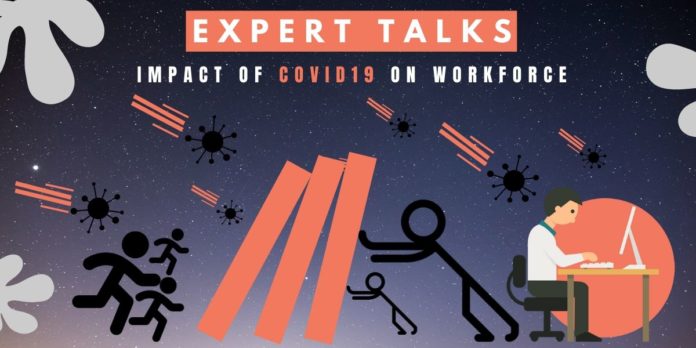2020 is clearly defined as “Before COVID19, During COVID19 and After COVID19“. The impact of COVID19 pandemic is everywhere and businesses are changing their ROI models to reach their customers in a best way. Here are thoughts from experts in the Digital Transformation, Artificial Intelligence, Cyber Security and Cloud Computing. Check the data and know more about the impact of COVID19 on the workforce at companies around the world.
What is the impact of COVID19 on the Workforce at Companies? – Digital Magazine
|
 |
Thoughts from Industry Experts
 |
Spiros Margaris
|
| The impact of COVID19 on the workforce and their future opportunities is severe since many companies need to scale back their ambitions. Due to the pandemic business models will need to adapt to a new situation where money will flow in different buckets, and customers needs and priorities change. | |
 |
Linda Grasso |
| The COVID-19 has put a strain on everyone. All companies, regardless of their size, faced and are still facing serious difficulties to survive in a global scenario brought to knees by the pandemic. Focusing on its impact, workforce management plays an important role. Social distancing has imposed a reorganization of human resources and their business processes through the adoption of so-called smart working. This change highlighted the importance of the paradigm shift of digital transformation inside the companies – thanks to the use of technology, we’ve seen that carrying out remote activities is possible and it can even make the workforce more efficient. | |
 |
Nicolas Babin |
| The impact of the pandemic of Covid-19 has forced companies to think about a new way of working. Employees were or still are in confinement and remote working needs to be implemented throughout the company. In the case where remote working is not possible, social distancing, wearing masks and hydroalcoholic gel need to be provided. Some companies have seen their revenue drop drastically and most of them had to transform using digital tools. Even small businesses such as restaurants have started to use social media to promote their businesses. Workforce had to change the way they interact with colleagues and bosses. Bosses also must ensure company values are still followed at a distance and trust has to be reinforced because people are not together all day anymore. Transformation has been forced on all for the good of companies. | |
 |
Ian Moyse |
| Most discussions around COVID have centred around technology. There was a rapid rush to the likes of Zoom, MS Teams and Google Hangouts to get workers online and able to group communicate visually. The tactical fix was pretty quick, resulting in an influx of demand for laptops and tools to meet the Work from home demands. We then moved into the reflection and appraisal stage where businesses started talking about what systems need changing, updating etc. Having been on many panels’ discussions around this, interestingly the conversation whilst headlined to be around such matters inevitably shifted to the people matter. We have quickly gone from a time when the norm was to deflect conversation to email, SMS, Whatsapp, social post, etc to wanting to speak. Verizons CEO just cited that they are seeing more phone calls per day, every day, than they normally see on their 2 peak days of the year (Mothers Day and New Years Day). We are seeing a time when employees want to engage with their colleagues and other people. The challenge we face is that we need to consider the mental strain on the employee; working in an isolated day and evening the same environment with distractions such as pets, kids, deliveries etc. Take also that the video group calls we are all too familiar with now are more draining on the individual than an in person meeting. Our brain is working harder to interpret a 2D face of the caller than when in person in the office or on a voice only call, add to this 6,10 or 20 other faces on a single call and unconsciously your brain is working far harder, hence we come away worn at the end of the call and day. Normally you are sat in a meeting and do not sit looking at flat faces, you look around, vary who you focus on and have 3D context. We are in a time when PCSD (Post Covid Stress Disorder) may become the next challenge businesses have to face. |
|
 |
Helen Yu |
| COVID 19 has reminded us about Maslow’s Hierarchy of Needs. Health and safety are among our most basic needs. We have to address these before we can address ones like career advancement or personal growth. COVID forces companies to change the way we work almost overnight. Despite initial fears and pressure, we discover that this new way of working could be a blueprint for the longer term. That’s what leaders of many companies around the globe are finding as they respond to COVID. McKinsey’s recent survey shows 87% of executives said they were experiencing skill gaps in the workforce. Upskilling the workforce becomes more urgent at companies. Companies’ ability to reskill and upskill the workforce to deliver new business models in the post-pandemic era will set them apart and allow them to better adapt to future disruptions. | |
 |
Giuliano Liguori |
| The impact of COVID19 is sweeping all across the world, as a result, companies must reorganize to quickly face this tough challenge. It is a calling both to maintain business continuity during the crisis than to take the right actions to become more resilient, not only in order to respond to this crisis but mainly to recover and thrive during these uncertain times. There are many aspects that companies should consider for workforces. – Improvement of social-cyber security by default – Flexible work arrangements to maintain the productivity – Business travel could be replaced by short remote meetings – There may be an acceleration in the adoption of digital technologies to bridge the digital divide – More automation and collaboration to simplify processes and reduce unnecessary costs. – Companies could provide extra wages to remote workers to allow them to organize their space in a way they feel is sufficient. It is impossible to mention in a few lines all the actions that companies could take, however, this flexibility will allow companies to remain productive and save money. |
|
 |
Vladimer Botsvadze |
| The COVID-19 has dramatically altered our experiences and our behaviors are changing as a result. Working from home has become the new normal. Nowadays the relationship is digitized between employer and employee. Brands that don’t innovate fast will be driven out of business. Companies should help employees build a learning mindset. Acceleration of new technologies will lead to the creation of new opportunities and jobs. According to the research of the World Economic Forum, 49% of senior risk experts believe unemployment is the consequence of the pandemic. It’s of paramount importance to focus on empathy and employee wellbeing. The world should build adaptive teams that can work remotely together.
With more than 43 million people filing for unemployment in the past seven months, many found themselves in unexpected situations and the majority have been working from their home. People have shown more interest in learning technologies and they are doing their best to work virtually. Wearing a mask around the office will become the new normal in top companies. My clients have successfully been working from home and doing their work remotely. Twitter and Shopify issued work-from-home orders for employees in Spring. Twitter employees received reimbursement for home office equipment including desks and chairs. The COVID-19 has accelerated the adoption of automation. Robots can streamline manufacturing and drones deliver goods. I predict this kind of automation adoption will increase on the horizon. Around 7.6 million jobs of the UK workforce are at risk because of lockdowns. Workers and small businesses are impacted by the pandemic. Brands are still working on strategies on how they will work in the short- and long-term. Organizations need fit-for-purpose plans today that solve global economic issues. We should play a decisive role in establishing a human-centered approach that promotes shared workforce resilience. |
|
 |
Enrico Molinari |
| Nothing will be like before. We know the companies’ business models in every sector and size will reborn profoundly rethought from the pandemic crisis. Smart Working has undoubtedly given a strong signal in this sense. Today the real challenge is to combine tech, innovation and business goals using Human Intelligence in synergy with Emerging Technologies. An example today is Twitter which, following the COVID‐19 pandemic, has allowed all employees to work for goals from home or from anywhere. We must collaborate today all together for preparing the “Next New”. | |
 |
Mauricio Amaro |
| The new organization and the way to collaborate have changed. Definitely moving so abruptly from a physical and centralized paradigm to a virtual and distributed one, it is an abrupt change, but one to which we must adapt since everything indicates that, perhaps with some nuance, it is here to stay.Evidently the necessary logistics is the first challenge to be faced. It is necessary to say which non portable equipment is better to move and to which to give them remote access, it is necessary to maintain a new balance between information security, physical security, adequate bandwidths, having active and sufficient VPNs, in addition to adding to this, the collaborative tools necessary for the coordination of business teams and secure and efficient videoconferencing.
And for me this is the most important paradigm shift. Productive collaboration is not done by generating a bunch of whatsapp that everyone writes about. Because those types of groups are eminently anarchic and what is needed now is an organization that allows us to achieve specific objectives. That is why the fundamental challenge is to understand how we work remotely, and not just try to emulate physical interaction in a virtual environment, because everything changes with respect to the form of relationship we are used to. There are new ways to understand the “etiquette” of conferences, to discern when video is necessary in them and when it is not (I particularly with my team do not use it frequently), for example. The biggest challenge is to adapt to the new cultures of the teams. |
|
 |
Tony Moroney |
| I think the biggest impact will be a re-calibration of the employer-employee value exchange. Many employees now realise the ineffectiveness of commuting and most likely, have a new perspective on what they value. For employers, the challenge is to shift their emphasis from inputs to outcomes. This is predicated on trust and underscores the necessity of firms to build strong cohesive cultures based on clarity of purpose and a shared vision. The future workforce will evolve on a blended basis with an emphasis on safety and employee experience. In essence, satisfied employees should lead to satisfied customers and long-term sustainable profitability. | |



